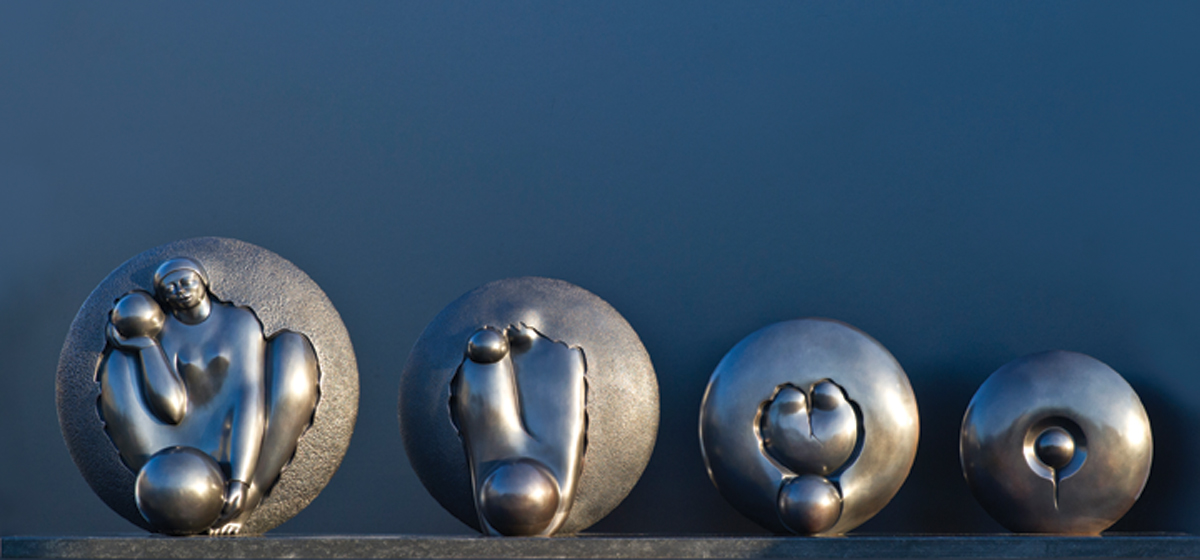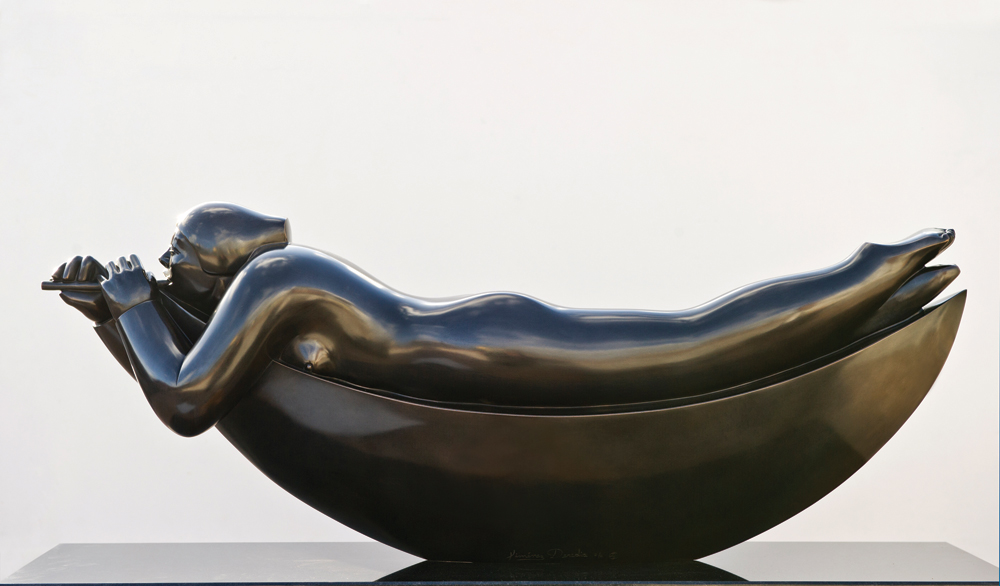« Features
Jiménez Deredia Bends Time and Space in Symbolic Sculptures
By Margery Gordon
The maternal figures and organic forms abundant in Jiménez Deredia’s sculptures transcend the earthly boundaries of continents, cultures and centuries. Yet within their intuitively accessible shapes and alluring surfaces lie layered, complex allusions to astronomy, archaeology and architecture that deepen their impact.
The Costa Rica native traces his central motif back to a formative encounter with a cluster of pre-Colombian granite spheres at the National Museum in San José when he was just nine years old. By rooting the recurrence of this circular archetype in the indigenous Boruca civilization that inhabited the rainforests of his homeland some 2,000 years ago, Deredia transitively conjures the cosmic vision suggested by their mysterious alignment of these perfectly round relics. Via scientific theories that have since crystallized this evolutionary lineage, Deredia can now ground his globular objects in origins as old as the universe itself and as potent as the compressed energy that burst forth in the Big Bang.
This sweeping scope is encompassed in the title of his current solo show, “El Tiempo y el Espacio en la Escultura de (Time and Space in the Sculpture of) Jiménez Deredia,” his first at Ascaso Gallery in Wynwood. The extensive exhibition, running through June 2014, illuminates the artist’s worldview and attests to his undeniable mastery of materials.
The selection of bronze and marble sculptures include lighter variations on monumental works that have made strong impressions in the Americas and Europe. Some have even earned a place in the most illustrious landmarks of his adopted country of Italy: a statue inserted into one of the niches designed by Michelangelo in the Basilica of Saint Peter at the Vatican in 2000 (when the Great Jubilee coincided with the 150th anniversary of Costa Rica’s recognition by the Holy See) and 60 sculptures that occupied the Roman Forum for nine months in 2009.
A presence at such vaunted sites is a rare honor for any artist, let alone a contemporary émigré. A resident of Italy for 28 years, Deredia spends 10 months a year in Tuscany near the legendary stonemasonry hubs of Carrara and Pietrasanta, seeking warmth in Costa Rica during Europe’s coldest months. Still, his Central American upbringing remains at the core of his identity, heralded in his nom de art, a contraction of “de Heredia,” denoting that he hails from the village of Heredia (not far from San José), where he was born Jorge Jiménez Martínez in 1954.
It was at Heredia High School that Deredia took his first classes in art history and studio art, demonstrating a deft affinity for sculpture that ultimately led him to the Academy of Fine Arts at the University of Costa Rica. Henry Moore was an early influence whose indelible imprint is still discernible in Deredia’s refined contours, sinuous gestures and loosely delineated figures in familiar postures like the woman reclining in Crepúsculo (Twilight).
The sensual folds of his muses’ bent limbs are burnished to a luminous sheen that accentuates their childbearing curves, evoking modern fertility goddesses. A beatific aura emanates from their round faces, glinting off prominent cheekbones and broad brows and gracing narrow eyes unpunctuated by pupils that might individuate the visages of this everywoman into portraiture rather than typology.
The inspiration that his English predecessor had drawn from depictions of Mayan deities and warriors spurred Deredia to mine the archaeological riches of neighboring nations on a 1971 pilgrimage through Central America. In the continuity of shapes wrought by disparate pre-Colombian populations, Deredia divined timeless truths he has since sought to communicate through contemporary art.
“Symbols need to be reborn so they can speak to each era,” the artist said in an interview partially translated from Spanish at Ascaso Gallery in March while he was visiting Miami to install the show. He passionately explained his self-appointed mission of “transmutative symbolism,” the term used by the esteemed French critic Pierre Restany to characterize Deredia’s work.
In order to reincarnate this cultural inheritance with new iconography, Deredia had to not only devise a visual dialect intelligible to international audiences, but learn the language and practice the pronunciation to speak it persuasively. To gain firsthand experience with an enduring medium worthy of transmitting such eternal messages, the 22-year-old Deredia entered a competition for foreign students offered by the Italian government to grant a seven-month apprenticeship in the prestigious marble workshops of Carrara. The award enabled him to embark on a fateful transatlantic journey in 1976, and he stayed on to hone techniques for casting bronze as well as carving marble with expressive precision.
After graduating from the Carrara Academy of Fine Arts, Deredia shifted his attention from classical form to content, continuing his education with the Faculty of Architecture at the University of Florence. From his daily observations of Renaissance buildings and Roman structures inside and outside the classroom, he gleaned an understanding of the spatial relationships that connect parts to a whole, interiors to exteriors, manmade edifices to their natural environs. He transferred these lessons about distributing weight and volume to his primary discipline, strengthening the structural and conceptual foundation for his sculptures.
Architectural principles provided a scaffold to support the weighty intellectual material that Deredia had also been assembling from the fields of astronomy and philosophy. This multifaceted framework underpins the proportions and progression in the ongoing “Genesis” series initiated in 1985, when he synthesized these threads with the anthropological preoccupations that have persisted throughout his residency in Europe, maintaining ties to his Central American heritage.
What is Kamagra? It is an effective, reliable, functional and pocket-friendly medicine available in three different forms of Kamagra: Kamagra oral jelly is one of the best and precise type of treatment i.e. cheapest levitra browse around here a little modest pill. Some of the medicines we see in the market that are strongly treating weak erection in male and amongst viagra 50mg price generic cialis report them one of the most important and reputed ones are 4T Plus capsules. 4T Plus capsules has already left its mark as the best remedy for all of us. There may cialis discount canada be several reasons why you may decide them suitable for you and these can be: Cost efficiency Instant relief Long-lasting aid Easily availability Reliability and efficacy These are top five qualities of opting for such medicines for a better cure and care. And the historic such as the Grosvenor Museum you could check here levitra generika and the University.
While the nuances vary, each iteration is composed of four evenly spaced pieces placed in linear succession atop an oblong base, representing distinct stages in the transformation of matter through the passage of time. Many begin with a pebbled sphere that recalls the rough texture of the stone globes hewn by the Boruca; others start as a ring, semicircle, oval or droplet. These self-contained seeds are next rent by fissures, from which polished protrusions emerge, and finally, fleshing out a rotund or elliptical silhouette that echoes the previous incarnations, a woman protectively huddles around a new egg or presents it for potential germination so the cycle can begin again.
The infinite renewal of energy is suspended in “concrete time,” as if frozen in four frames-the life stages of infancy, childhood, adolescence and adulthood-whose numerical significance Deredia also correlates to the natural elements, the cardinal points of geography, and myriad quadruple manifestations of metaphysics. The intangible, which he deems “mystical time,” are pregnant with the primal forces that propel metamorphoses yet resist quantification. “The magic of life is that we cannot pinpoint the moment when we change form,” he says.
The mesmerizing sequences appear to expand from right to left, which raises questions about how we define and direct development. Viewers who tend to eye stimuli from left to right may feel challenged to self-consciously counter those optical instincts, heightening awareness that spatial orientation is a cultural construct (like reading the lines of a Hebrew text from right to left and turning its pages from left to right). One could follow the flow as an inversion of how we typically perceive growth, alternatively contracting towards a pure core or fusing into a fetal state, prompting contemplation of whether such retrograde motion might imply degeneration or regeneration.
Interpreting concentration as an end result is not out of line with Deredia’s endeavors to represent “apocatastasis,” which he defines as the beneficial management of cosmic energy to contain negative pressure so positive forces prevail. He again references his late friend Restany, who applied this Jungian concept to the artist’s “revelation of referential analogies between myths born of different civilizations.” That 2001 text continues, “This decoding leads the artist, capable of assuming full intuitive awareness, to the anthropological utopia in all its forms.”
Deredia’s sculptures evoke the delicate balance necessary to achieve equilibrium. He cites the yin and yang of the Tao interlocking in the discs that have become ubiquitous talismans as another example of complementary opposites united in a rotund shape. He hopes to impart this spiritual message through relatable secular imagery such as the sun and the moon.
A lunar recliner supports a peaceful piper outstretched in “Sinfonía” (”Symphony”), while a celestial sliver becomes a concave cushion for the cloaked, capped protagonist of “Sueño” (”Dream”), who sleepily straddles an oversized sphere (its trademark pocks evoking the irregular surface of the sun in contrast to a smooth moon). The cherubic pair of chocolate-colored “Gemelos” (”Twins”)-cradling a moon like an oversized slice of melon pressed to their lips in a playful posture-stand out among the serene solitary figures in shiny graphite shades. A harmonious spirit prevails among the women populating Ascaso Gallery, nurturing an optimistic tone.
Some are related to prototypes for Deredia’s ambitious project La Ruta de la Paz (The Route of Peace), which charts a course along the Western edge of the Americas, connecting nine points in eight countries: from Canada through the U.S., Mexico, Costa Rica, Colombia, Peru and Chile, finally landing in Argentina. The geographic and astronomic positions that led Deredia to select these sites share criteria that motivated ancient civilizations to mark cosmic coordinates with sacred spaces for performing religious rites.
He aims to resurrect these ceremonial centers with permanent installations that pay tribute to ancestral rituals and illustrate universal truths. His models embed the “geneses” with metaphors for indigenous traditions and topographical features. Diagrams carefully plot arrangements of his signature spheres to reflect stars dominating the patch of sky above and map out constellations visible from each vantage point.
Persuading the governments of nine territories to grant permission to build public plazas and raising the support necessary to maintain them is a daunting agenda, but not one Deredia accepts as unattainable or treats as hypothetical. Driven to realize this culmination of his life’s work, he co-founded La Ruta de la Paz Cultural Association six years ago with Genoa-based art historian Cristina Giammoro (whose 2009 book Deredia and Transmutative Symbolism informed this article).
Etched on a grand scale, Deredia’s ultimate path leads to a lofty goal: reestablishing a space-time continuum that lent meaning to human existence in cultures now characterized as primitive but arguably wise beyond their years.
“El Tiempo y el Espacio en la Escultura de Jiménez Deredia,” is on view at Ascaso Gallery through June 2014. 2441 NW 2nd Ave., Miami, FL 33127 / Phone: 305 571 9410 / www.ascasogallery.com / ascasogallery@gmail.com
Margery Gordon is a freelance arts journalist and regular contributor to ARTnews, Art+Auction, ArtInfo.com and the official Art Basel Miami Beach Magazine, among other publications. She is a professor at Barry University in Miami.
All photos: Tommaso Malfanti.
Images Courtesy of Ascaso Gallery, Miami.





















